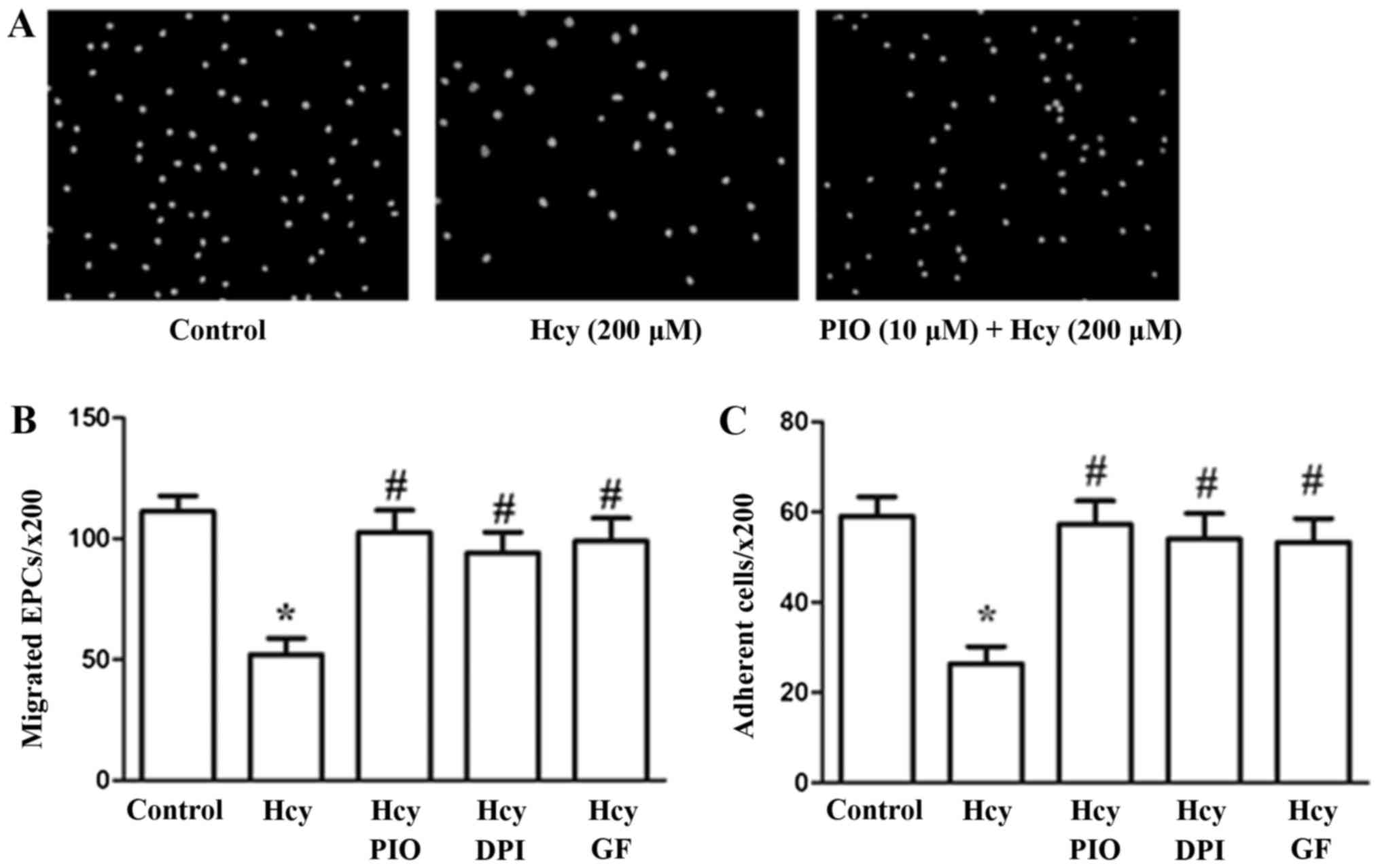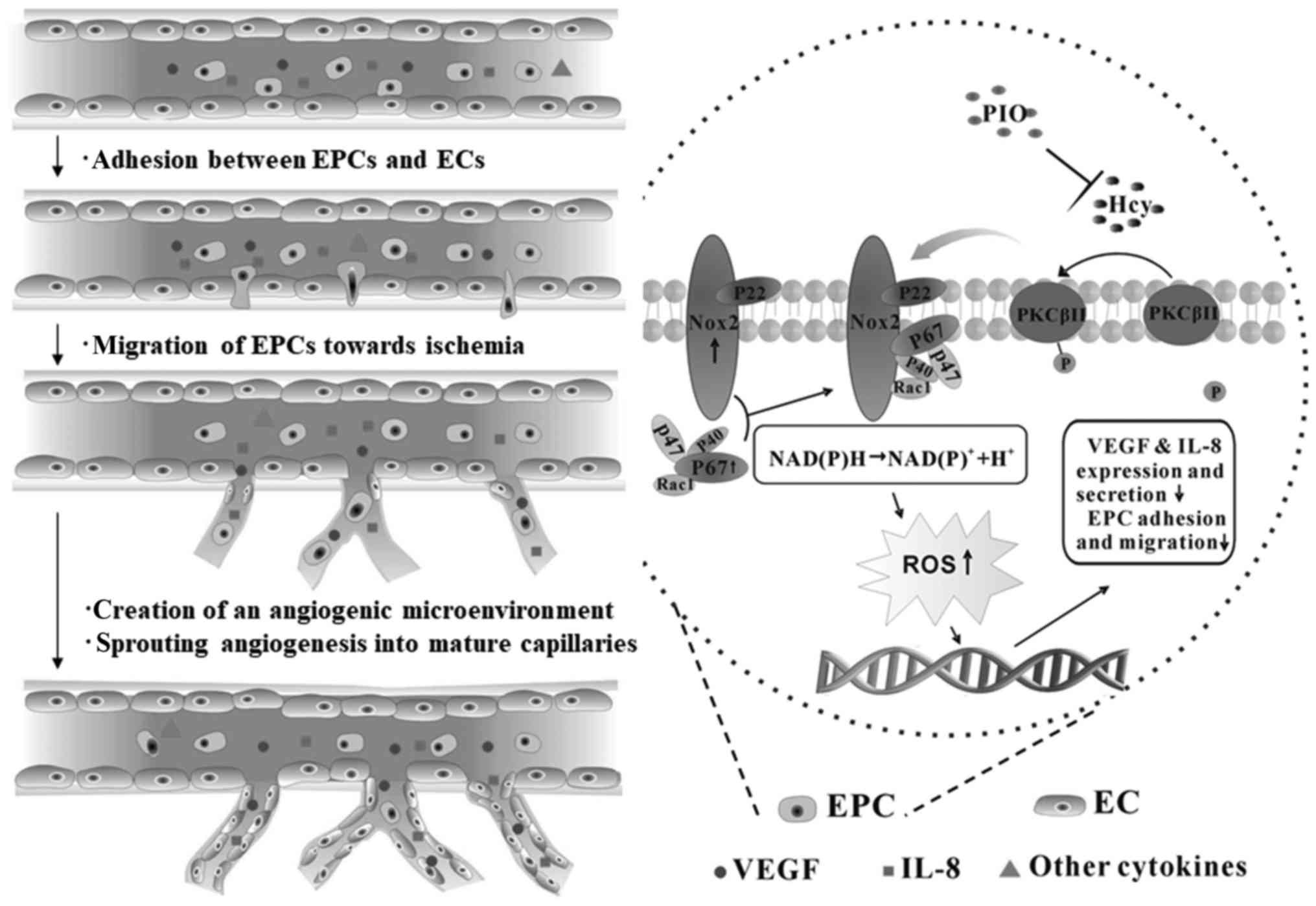|
1
|
Abe Y, Ozaki Y, Kasuya J, Yamamoto K, Ando
J, Sudo R, Ikeda M and Tanishita K: Endothelial progenitor cells
promote directional three-dimensional endothelial network formation
by secreting vascular endothelial growth factor. PLoS One.
8:e820852013. View Article : Google Scholar : PubMed/NCBI
|
|
2
|
Zhu JH, Chen JZ, Wang XX, Xie XD, Sun J
and Zhang FR: Homocysteine accelerates senescence and reduces
proliferation of endothelial progenitor cells. J Mol Cell Cardiol.
40:648–652. 2006. View Article : Google Scholar : PubMed/NCBI
|
|
3
|
Chen JZ, Zhu JH, Wang XX, Zhu JH, Xie XD,
Sun J, Shang YP, Guo XG, Dai HM and Hu SJ: Effects of homocysteine
on number and activity of endothelial progenitor cells from
peripheral blood. J Mol Cell Cardiol. 36:233–239. 2004. View Article : Google Scholar : PubMed/NCBI
|
|
4
|
Bao XM, Wu CF and Lu GP: Atorvastatin
inhibits homocysteine-induced oxidative stress and apoptosis in
endothelial progenitor cells involving Nox4 and p38MAPK.
Atherosclerosis. 210:114–121. 2010. View Article : Google Scholar : PubMed/NCBI
|
|
5
|
Wang W, Vellaisamy K, Li G, Wu C, Ko CN,
Leung CH and Ma DL: Development of a long-lived luminescence probe
for visualizing β-galactosidase in ovarian carcinoma cells. Anal
Chem. 89:11679–11684. 2017. View Article : Google Scholar : PubMed/NCBI
|
|
6
|
Ko CN, Wu C, Li G, Leung CH, Liu JB and Ma
DL: A long-lived ferrocene-conjugated iridium(III) complex for
sensitive turn-on luminescence detection of traces of DMSO in water
and human serum. Anal Chim Acta. 984:193–201. 2017. View Article : Google Scholar : PubMed/NCBI
|
|
7
|
Mazzone T, Meyer PM, Feinstein SB,
Davidson MH, Kondos GT, D'Agostino RB Sr, Perez A, Provost JC and
Haffner SM: Effect of pioglitazone compared with glimepiride on
carotid intima-media thickness in type 2 diabetes: A randomized
trial. JAMA. 296:2572–2581. 2006. View Article : Google Scholar : PubMed/NCBI
|
|
8
|
Spigoni V, Picconi A, Cito M, Ridolfi V,
Bonomini S, Casali C, Zavaroni I, Gnudi L, Metra M and Dei Cas A:
Pioglitazone improves in vitro viability and function of
endothelial progenitor cells from individuals with impaired glucose
tolerance. PLoS One. 7:e482832012. View Article : Google Scholar : PubMed/NCBI
|
|
9
|
Gensch C, Clever YP, Werner C, Hanhoun M,
Böhm M and Laufs U: The PPAR-gamma agonist pioglitazone increases
neoangiogenesis and prevents apoptosis of endothelial progenitor
cells. Atherosclerosis. 192:67–74. 2007. View Article : Google Scholar : PubMed/NCBI
|
|
10
|
Imanishi T, Kobayashi K, Kuroi A, Ikejima
H and Akasaka T: Pioglitazone inhibits angiotensin II-induced
senescence of endothelial progenitor cell. Hypertens Res.
31:757–765. 2008. View Article : Google Scholar : PubMed/NCBI
|
|
11
|
Jiang X, Yang F, Tan H, Liao D, Bryan RM
Jr, Randhawa JK, Rumbaut RE, Durante W, Schafer AI, Yang X and Wang
H: Hyperhomocystinemia impairs endothelial function and eNOS
activity via PKC activation. Arterioscler Thromb Vasc Biol.
25:2515–2521. 2005. View Article : Google Scholar : PubMed/NCBI
|
|
12
|
Siow YL, Au-Yeung KK and Woo CW OK:
Homocysteine stimulates phosphorylation of NADPH oxidase p47phox
and p67phox subunits in monocytes via protein kinase Cbeta
activation. Biochem J. 398:73–82. 2006. View Article : Google Scholar : PubMed/NCBI
|
|
13
|
Xu S, Zhao Y, Jin C, Yu L, Ding F, Fu G
and Zhu J: PKC/NADPH oxidase are involved in the protective effect
of pioglitazone in high homocysteine-induced paracrine dyfunction
in endothelial progenitor cells. Am J Transl Res. 9:1037–1048.
2017.PubMed/NCBI
|
|
14
|
Nelson J, Wu Y, Jiang X, Berretta R,
Houser S, Choi E, Wang J, Huang J, Yang X and Wang H:
Hyperhomocysteinemia suppresses bone marrow CD34+/VEGF receptor 2+
cells and inhibits progenitor cell mobilization and homing to
injured vasculature-a role of β1-integrin in progenitor cell
migration and adhesion. FASEB J. 29:3085–3099. 2015. View Article : Google Scholar : PubMed/NCBI
|
|
15
|
Bao XM, Wu CF and Lu GP: Atorvastatin
inhibits homocysteine-induced dysfunction and apoptosis in
endothelial progenitor cells. Acta Pharmacol Sin. 31:476–484. 2010.
View Article : Google Scholar : PubMed/NCBI
|
|
16
|
Werner C, Gensch C, Pöss J, Haendeler J,
Böhm M and Laufs U: Pioglitazone activates aortic telomerase and
prevents stress-induced endothelial apoptosis. Atherosclerosis.
216:23–34. 2011. View Article : Google Scholar : PubMed/NCBI
|
|
17
|
Alvarez-Maqueda M, El Bekay R, Monteseirín
J, Alba G, Chacón P, Vega A, Santa María C, Tejedo JR, Martín-Nieto
J, Bedoya FJ, et al: Homocysteine enhances superoxide anion release
and NADPH oxidase assembly by human neutrophils. Effects on MAPK
activation and neutrophil migration. Atherosclerosis. 172:229–238.
2004. View Article : Google Scholar : PubMed/NCBI
|
|
18
|
Ungvari Z, Csiszar A, Edwards JG, Kaminski
PM, Wolin MS, Kaley G and Koller A: Increased superoxide production
in coronary arteries in hyperhomocysteinemia: Role of tumor
necrosis factor-alpha, NAD(P)H oxidase, and inducible nitric oxide
synthase. Arterioscler Thromb Vasc Biol. 23:418–424. 2003.
View Article : Google Scholar : PubMed/NCBI
|
|
19
|
Sirker A, Zhang M and Shah AM: NADPH
oxidases in cardiovascular disease: Insights from in vivo models
and clinical studies. Basic Res Cardiol. 106:735–747. 2011.
View Article : Google Scholar : PubMed/NCBI
|
|
20
|
Bedard K and Krause KH: The NOX family of
ROS-generating NADPH oxidases: Physiology and pathophysiology.
Physiol Rev. 87:245–313. 2007. View Article : Google Scholar : PubMed/NCBI
|
|
21
|
Krenning G, van Luyn MJ and Harmsen MC:
Endothelial progenitor cell-based neovascularization: Implications
for therapy. Trends Mol Med. 15:180–189. 2009. View Article : Google Scholar : PubMed/NCBI
|














